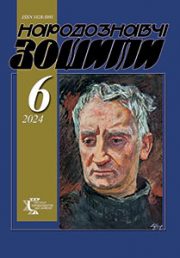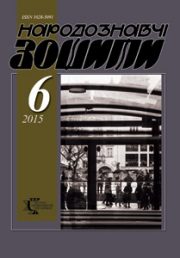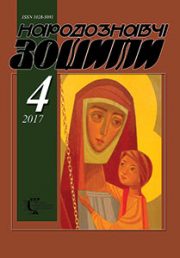The Ethnology Notebooks. 2025. № 4 (184), 841—850
UDK[7.011.26.074:39](477.85/.87=161.2)В.Шухевич:069.5(477.83-25)
DOI https://doi.org/10.15407/nz2025.04.841
SOBUTSKA Liubava
- ORCID ID: https://orcid.org/0009-0003-4419-5313
- head of the Folk Art Department
- of the Andrey Sheptytskyi
- National Museum in Lviv,
- 20, Svobody Avenue, 79000, Lviv, Ukraine,
- Contacts: e-mail:SbavaM@gmail.com
Abstract. The article examines and analyzes the unique collection of Volodymyr Shukhevych, which is stored in the folk art funds of the National Museum in Lviv. The purpose of the article is to trace the history of the collection from V. Shukhevych’s fascination with art, its formation and display at exhibitions to the decision to transfer the collection to the National Museum of Fine Arts. And also to highlight its further fate after the death of V. Shukhevych, as part of the museum’s collection. The subject of the study is works of folk art and ethnography of the Hutsul region, Pokuttya and other ethnographic regions, which are highly artistic works by famous and unknown masters of traditional art.
The relevance of the article is to highlight the activities of an influential public figure who was aware of the contemporary problems of collecting and museology and managed to assemble a holistic and original collection that has not yet become the subject of thorough scientific research. In the article, it is important to highlight folk art objects stored in various preservation fund groups and present them as a holistic, separate collection. V. Shukhevych formed it as a broad-based collection, as evidence of the artistry of the Ukrainian people, and was concerned about its further fate.
Source base of the research: works of pottery, carving, weaving, embroidery, Easter egg making, etc.; periodicals and publications of the late 19th — first third of the 20th century, correspondence of V. Shukhevych and I. Svientsitskyi, catalogs and works of researchers of the late 20th — early 21st century.
When writing the article, attention was focused on the main historical events that influenced the formation of the collection and the decision to transfer it to the museum; art historical analysis of various groups of monument preservation was applied.
Keywords: collection, folk art, Hutsulshchyna, Volodymyr Shukhevych, museum, pottery, embroidery, carving, pysankarstvo, bead weaving, paper cutting.
Received 8.07.2025
REFERENCES
- Olesnytskyi, E. (1915, April 24). Volodymyr Shukhevych: (obituary). Dilo, 16, 2 [in Ukrainian].
- Sobutska, L. (2021). Volodymyr Shukhevych’s Cooperation with the National Museum in Lviv. Chronicle of the National Museum in Lviv named after Andrey Sheptytsky, 12 (17), 81—85 [in Ukrainian].
- Gordiy, M., & Helyas, B. (2004). Volodymyr Shukhevych: biobibliographer. Index: in 2 parts (Part 1). Lviv: Publishing center of Ivan Franko National University of Lviv [in Ukrainian].
- Shukhevych, V. (1913). Letter from V.Y. Shukhevych to I.S. Sventsitsky. October 14, 1913. Sector of Archival Materials and Photographic Archives (A-174/3, ark. 3), NML Archives, Lviv, Ukraine [in Ukrainian].
- (1913, December 15). Opening of the National Museum. Dilo, 279, 3—4 [in Ukrainian].
- (1916, April 5). In memory of the late Volodymyr Shukhevych. Dilo, 89, 1 [in Ukrainian].
- Sventsitsky, I. (Ed.). (1913). Twenty-five years of the National Museum in Lviv. Republished by the National Museum in Lviv named after Andrey Sheptytsky since 1930. Lviv [in Ukrainian].
- Sventsitsky, I. (1918, October 3). National Museum in Lviv: Report for the month of September. Dilo, 224, 3 [in Ukrainian].
- Posatska, D. (2008). Catalog of lost works of the National Museum in Lviv named after Andrey Sheptytsky (1940—1941). Kyiv; Lviv [in Ukrainian].
- Mateyko, K. (2011). About the associates of Ukrainian art. Ethnographic notebooks, 4, 624—628 [in Ukrainian].
- Sobutska, L. (2024). Embroidered shirts of Pokuttya of the second half of the 19th — mid-20th centuries from the collection of the National Museum in Lviv named after Andrey Sheptytsky. Master of Books [in Ukrainian].
- Shukhevych, V. (1912, January 22). An appeal to our Women to make a donation to the National Museum. Dilo, 17, 7; 40 (supplement) [in Ukrainian].
- Fedorchuk, O. (2021). The tradition of bead decoration of Ukrainian folk costumes (based on materials from the western regions of Ukraine). Institute of Ethnology of the NAS of Ukraine [in Ukrainian].
- Molyn, V. (2014). Exhibition of Home Crafts in Kolomyia (a look through the ages). Ethnographic Notebooks, 1 (115), 130—136 [in Ukrainian].
- Sobutska, L., Bila, O. (Ed.). (2013). Collection of Easter Eggs of the National Museum in Lviv named after A. Sheptytsky: History of Formation and Scientific Research. In: Preservation and Research of Historical and Cultural Heritage in Museum Collections: Historical, Art History and Museological Aspects of Activity: Supplement and Report of the International Scientific Conference (Lviv, September 25—27, 2013) (Pp. 146—153). Lviv: National Museum in Lviv [in Ukrainian].






